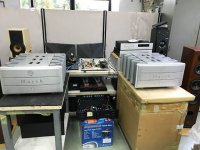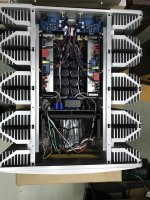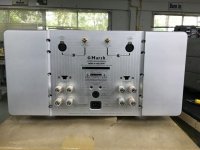Some papers I had researched used a zero crossing model for localization. It seemed far too simplistic for a complex musical soundfield where assymetrical lower frequency content would provide a different DC level to higher frequencies, and then mess up the ITD timing. Unless of course the coils do a progressive high pass with distance.
I suspect there is far more processing going on between the ears than just zero crossing timing.
Well, except for Billy Joe, Betty Joe and Bobby Joe... 😀
I'm not at work, I'll see if I can find the papers next week.
Jn
I looked into localization using zero crossing, JN & from what I gather it's in the realm of computational auditory scene analysis (CASA) using specifc sets of algorithms - which is interesting in & of itself. It may have application for hearing aids, etc but is not necessarily a good analog to the workings of auditory perception
Last edited:
LSD (but within reason) gives a great insight into just how our perceptions are internally generated & experiencing synesthesia directly confirms this
Been there LSD, with any control (i.e. within reason) does not compute. Once one has gone down this path the straight edge is hard to take. The pure output of energy with no substances at all is invigorating and equally revealing. Get down in the pit at a 1980's Minor Threat concert. I miss Waly.
YouTube
Last edited:
I'm talking about control over the number of times taken rather than the trip itself (although correct surrounding environment & people is important). Not sure what the straight edge means?Been there LSD, with any control (i.e. within reason) does not compute. Once one has gone down this path the straight edge is hard to take.
The pure output of energy with no substances at all is invigorating and equally revealing. Get down in the pit at a 1980's Minor Threat concert. I miss Waly.
YouTube
Sure, I know the experience - I've abandoned myself to physicality too (without & with substances) but still not interested in the pit
Last edited:
I went to a Messiaen concert once. After an hour and a half of 'des canyons aux étoiles' I really wasn't sure what had just happened to me. And something that a 2 channel replay system, whatever you do to it has not a hope in hell of recreating.
Time to retreat to the shed and build a 7.1 sound egg for myself.
Time to retreat to the shed and build a 7.1 sound egg for myself.
As I recall, I had the best luck when I was using google scholar. I've been quite pleasantly surprised by how well it worked when looking for research. When I was researching micro wire EDM for my home build, it was great searching and not having half the results being bikini clad women with pacifiers in their mouth or deadmouse pics. I mean, I do like EDM (and bikini clad women of course), but when I'm searching electron discharge machining, just stop with the non topics..I looked into localization using zero crossing, JN & from what I gather it's in the realm of computational auditory scene analysis (CASA) using specifc sets of algorithms - which is interesting in & of itself. It may have application for hearing aids, etc but is not necessarily a good analog to the workings of auditory perception
Zero crossing is a good ITD measure, but it requires knowing the frequency. It seemed so counter to what I would expect. I hope I still have my notebook with the localization stuff.
Jn
Congrats Richard, I am sure we look forward to your findings. 😎Breaking News: CMA -- Almost done and in final testing ---
High Slew rate, Very Low Noise, Ultra low distortion at any frequency and any power level and any load impedance.
Very accurate sound reproduction quality.
Dan.
Last edited:
Have you some other complex music you could try? Full orchestra for example. I often use familiar Zappa pieces as a test, complex, multi-layered mixes, immaculately produced.After some rumination, I think it maybe it is the cheapo nasty class d bridged mono bus pumping chip amp that is at fault. Solution is to drop the eq by -2b at 50hz. Seems less bothersome now with the newish alnico speaker than the ceramic one before it. Methinks the alnico magnet is buffering the current - perhaps - perhaps not, but the cloth surround and spider after a 100 hundred hours is still breaking in, and is taking at least 30 minutes at the beginning of a session to loosen up.
I don't listen to rock music all that much, but I do like Grotus. Very funny, very political and the singer has a voice like a chainsaw. A band that makes fuzz sound intelligent, like an educated punch to the head.
Sadly, I've given up using emoticons, they're just not funny enough.
Horns can be great, but can also be difficult to get right, your speakers are a bit of an unknown quantity. You mentioned that they are lacking in the extremities, this could be a factor.
There's always the option of Max's goop, guaranteed to remedy all known maladies, unfortunately it isn't available to us mere mortals yet, and I doubt it ever will be....
Thank God! 😉I went to a Messiaen concert once. After an hour and a half of 'des canyons aux étoiles' I really wasn't sure what had just happened to me. And something that a 2 channel replay system, whatever you do to it has not a hope in hell of recreating.
Here is me in my lab. I have plenty to do.
With all that history stuff no wonder "dust off" is at the top!😀
Thank God! 😉
Some of us* like Messiaen (in controlled doses).
* ok might be one of us...
🙂 I was thinking more along the lines, how many of us would really want the full concert experience in our living rooms even if it was attainable? There have been a few threads lately along the lines of, how do I get a realistic reproduction of real instruments in my room blah blah blah.... I question how desirable it really is.
Technically it is quite impossible to achieve, however quite satisfying result is possible for a smaller chamber orchestra or string quartet. I think we who visit live classical concerts on a regular basis prefer more neutral and less colored sound. Thus the neverending debates. For example, I do not like sound of big horns like Lowther or Oris.
Last edited:
I have started wondering if the smyth realiser and good headphones is really the next step? You still cannot replicate the experience of going to a concert hall, and that will always remain elusive.
Yes, sorry....😱🙂Thus the neverending debates.
I've not heard them, wouldn't mind the opportunityFor example, I do not like sound of big horns like Lowther or Oris.
GM described OB as an "unfolded horn"?
Last edited:
Headphones would need extremely good headphone sound processor and special recording techniques (like artificial head), otherwise the space is unnatural. You do not want the sound in the middle of your head.
quoted by Scott Wurcer:
I too like Messiaen, but small doses.
You can write computer programs to generate this sort of stuff. Just feed it some genuine physics paper to digest, and a random number generator. If you are lucky it will fool potential investors; if you are really lucky some ignorant general will throw defence money at you too.Contrary to classical electrodynamics assumption, generators and batteries do not use their available internal energy to power their external circuit, but only to perform work on their own internal charges, separating them to form the source dipole connected to their terminals. As is well-known in particle physics, any dipole is a broken 3-symmetry in its violent energetic exchange with the active vacuum. This means that the source dipole—once formed in the generator or battery—transduces some of the unusable virtual flux energy—continuously absorbed from the vacuum—into real, 3-space, observable EM energy and pours it out in all directions.
It is easy to frighten yourself with time domain waveforms. DA is linear and only affects very low frequencies, hence it can be ignored for audio. If there is some other dielectric problem which happens to be well correlated with DA then that is a separate issue.RNMarsh said:If you measure this with a small R -- fast charge time with polar type cap and asymmetrical transient waveform, you will see it.
I too like Messiaen, but small doses.
🙂 I was thinking more along the lines, how many of us would really want the full concert experience in our living rooms even if it was attainable? There have been a few threads lately along the lines of, how do I get a realistic reproduction of real instruments in my room blah blah blah.... I question how desirable it really is.
I surely would and I'm also aiming for it 🙂
//
Nah, my right ear was damaged permanently in an accident in the 60's. I still had no problem appreciating the improvements that kevinkr made to his system.
Sorry about that, would not wish that on anybody. But one ear can still be discerning, I know this from others too.
I have started wondering if the smyth realiser and good headphones is really the next step? You still cannot replicate the experience of going to a concert hall, and that will always remain elusive.
One will lose the tactile experience.... no good.. :-/
//
- Status
- Not open for further replies.
- Home
- Member Areas
- The Lounge
- John Curl's Blowtorch preamplifier part III


